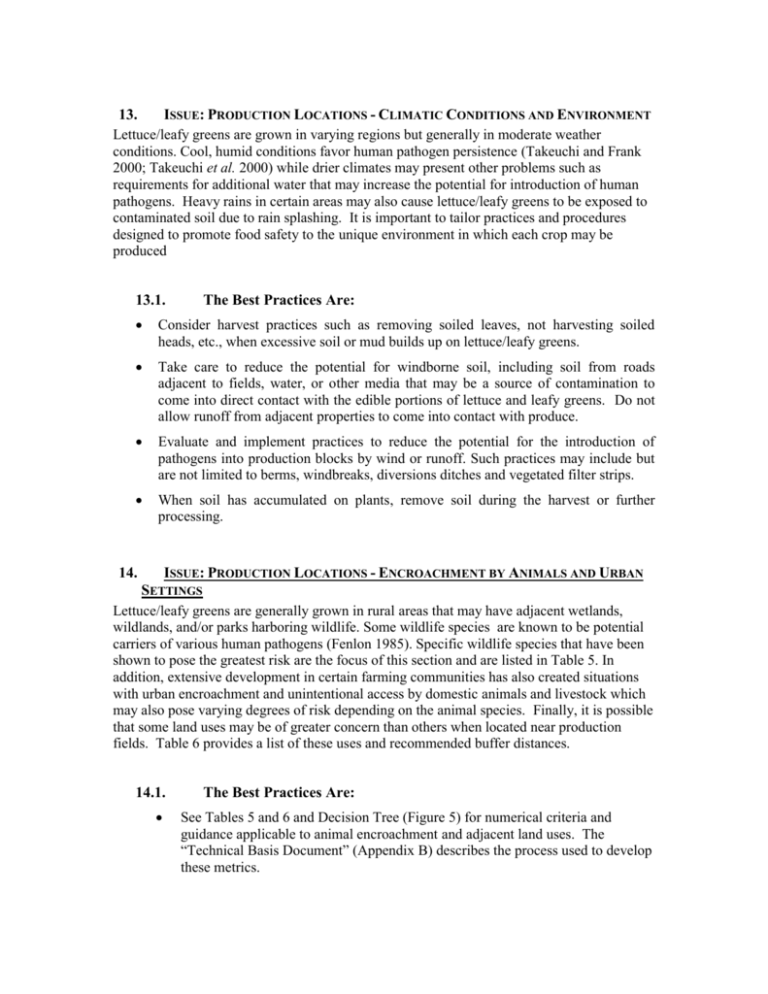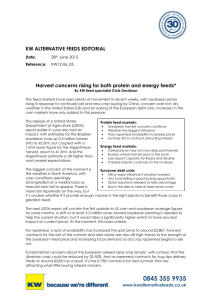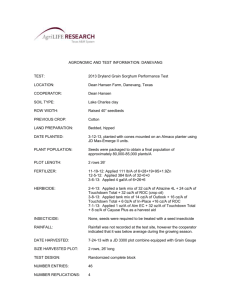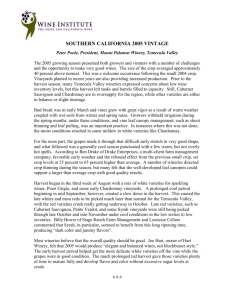Lettuce & Leafy Greens Prod. & Harvest BP Draft
advertisement

13. ISSUE: PRODUCTION LOCATIONS - CLIMATIC CONDITIONS AND ENVIRONMENT Lettuce/leafy greens are grown in varying regions but generally in moderate weather conditions. Cool, humid conditions favor human pathogen persistence (Takeuchi and Frank 2000; Takeuchi et al. 2000) while drier climates may present other problems such as requirements for additional water that may increase the potential for introduction of human pathogens. Heavy rains in certain areas may also cause lettuce/leafy greens to be exposed to contaminated soil due to rain splashing. It is important to tailor practices and procedures designed to promote food safety to the unique environment in which each crop may be produced 13.1. The Best Practices Are: Consider harvest practices such as removing soiled leaves, not harvesting soiled heads, etc., when excessive soil or mud builds up on lettuce/leafy greens. Take care to reduce the potential for windborne soil, including soil from roads adjacent to fields, water, or other media that may be a source of contamination to come into direct contact with the edible portions of lettuce and leafy greens. Do not allow runoff from adjacent properties to come into contact with produce. Evaluate and implement practices to reduce the potential for the introduction of pathogens into production blocks by wind or runoff. Such practices may include but are not limited to berms, windbreaks, diversions ditches and vegetated filter strips. When soil has accumulated on plants, remove soil during the harvest or further processing. 14. ISSUE: PRODUCTION LOCATIONS - ENCROACHMENT BY ANIMALS AND URBAN SETTINGS Lettuce/leafy greens are generally grown in rural areas that may have adjacent wetlands, wildlands, and/or parks harboring wildlife. Some wildlife species are known to be potential carriers of various human pathogens (Fenlon 1985). Specific wildlife species that have been shown to pose the greatest risk are the focus of this section and are listed in Table 5. In addition, extensive development in certain farming communities has also created situations with urban encroachment and unintentional access by domestic animals and livestock which may also pose varying degrees of risk depending on the animal species. Finally, it is possible that some land uses may be of greater concern than others when located near production fields. Table 6 provides a list of these uses and recommended buffer distances. 14.1. The Best Practices Are: See Tables 5 and 6 and Decision Tree (Figure 5) for numerical criteria and guidance applicable to animal encroachment and adjacent land uses. The “Technical Basis Document” (Appendix B) describes the process used to develop these metrics. During the Environmental Assessments discussed in Section 2, the location of any adjacent land uses that are likely to present a food safety risk should be documented. In addition, as specified in Table 6, any deviations from the recommended buffer distances due to mitigation factors or increased risk should be documented. Fencing, vegetation removal, and destruction of habitat may result in adverse impacts to the environment. Potential adverse impacts include loss of habitat to beneficial insects and pollinators; wildlife loss; increased discharges of sediment and other pollutants resulting from the loss of vegetative filtering; and increased air quality impacts if bare soil is exposed to wind. It is recommended that producers check for local, state, and federal laws and regulations that protect riparian habitat and wetland areas, restrict removal of vegetation or habitat, or regulate wildlife deterrence measures, including hazing, harassment, lethal and non-lethal removal, etc. Document any observed encroachment by animals of significant risk during production periods. Evaluate and monitor animal of significant risk activity in and proximate to lettuce/leafy greens fields and production environments. Conduct periodic monitoring, pre-season, pre-harvest, and harvest assessments. If there are animals of significant risk present, make particular efforts to reduce their access to lettuce and leafy green produce. Evaluate the risk to subsequent crop production on production acreage that has experienced recent postharvest grazing with or by domesticated animals that used field culls as a source of animal feed. Locate production blocks to minimize potential access by animals of significant risk and maximize distances to possible sources of microbial contamination. For example, consider the proximity to water (i.e., riparian areas), animal of significant risk harborage, open range lands, non-contiguous blocks, urban centers, etc. Periodically monitor these factors and assess during preseason and preharvest assessments as outlined in Tables 5 and 6. If the designated food safety professional deems that there is the potential for microbial contamination from adjacent areas, a risk assessment shall be performed to determine the risk level as well as to evaluate potential strategies to control or reduce the introduction of human pathogens. DO NOT harvest areas of fields where unusually heavy activity by animals of significant risk occurs. If animal of significant risk intrusions are common on a particular production field, consider fencing, barriers, noisemakers, and other practices that may reduce intrusions. Train harvest employees to recognize and report evidence (e.g., feces) of animal of significant risk activity. Pooled water (e.g., a seasonal lake) from rainfall may attract animals of significant risk and should be considered as part of any land use evaluation. Consider controlling risks associated with encroachment by urban development. Risks may include, but are not limited to, domestic animal fecal contamination of production fields and harvest equipment and septic tank leaching. Growers are encouraged to contact the relevant agencies (e.g., the Regional Water Quality Control Board and state and federal fish and wildlife agencies) to confirm the details of these requirements. In addition, growers may wish to consult with local NRCS to evaluate the food safety risks associated with wildlife of significant risk, livestock, domestic animals and other adjacent land uses and to develop and document strategies to control or reduce the introduction of human pathogens through wildlife of significant risk for each production block. TABLE 5. ANIMAL OF SIGNIFICANT RISK ACTIVITY IN FIELD (WILD OR DOMESTIC) When evidence of animal of significant risk intrusion in a production block occurs. Issue Evidence of Intrusion Allowable Harvest Distance from Evidence of Intrusion Metric Frequency There shall be a periodic monitoring plan in place for production fields. There shall be Pre Season, Pre Harvest, and Harvest Assessments Remedial Actions If there is evidence of intrusion by animals of significant risk, the production block must undergo a detailed food safety assessment by appropriately trained food safety personnel (see Glossary) prior to harvest, as defined in the text of this document. In developing remedial and corrective actions, consider Variables consulting with wildlife and/or domestic animal experts as appropriate. Physical observation of animals in the field If remedial actions cannot be formulated that control or Downed fences eliminate the identified risk, destroy the block by Animal tracks in production block disking under the crop. Animal feces or urine in production block Equipment used to destroy crop must be cleaned and Eaten plants in production block sanitized upon exiting the field. Investigate potential causes for intrusion by animals of Animals of Significant Risk significant risk and assess the extent of intrusion and Deer impact on crop food risk. Pigs (wild and domestic) Formulate effective corrective actions. Prior to taking Cattle action that may affect natural resources, growers should Goats and Sheep check local, state and federal laws and regulations that protect riparian habitat and wetland areas, restrict removal of vegetation or habitat, or regulate wildlife deterrence measures, including hazing, harassment, lethal and non-lethal removal, etc. Evidence of intrusion by animals of significant risk and corrective actions shall be documented and available for verification for a period of two years. Please see Figure 5. Decision Tree for Conducting Pre-Harvest and Harvest Assessments. Monitoring Evaluate and monitor animal of significant risk activity in and proximate to lettuce/leafy greens fields and production environments. Conduct periodic monitoring, pre-season, pre-harvest, and harvest assessments. Pre Harvest Assessment: Conduct the pre-harvest assessment not more than one week prior to harvest. Fecal Material Do not harvest any produce that has come into direct contact with fecal material. If evidence of fecal material is found, conduct a food safety assessment using qualified personnel. Do not harvest any crop found Issue Metric Remedial Actions within a minimum 5 foot radius buffer distance from the spot of the contamination unless remedial action can be found that adequately control the risk. The food safety professional can increase this buffer distance if deemed appropriate. Remove fecal material from the field and dispose of properly. Intrusion If evidence of animal of significant risk intrusion is found in a production field, conduct a visual food safety assessment to determine whether the areas of intrusion can be adequately controlled (e.g., solitary deer track with no evidence of feeding), or whether a three foot buffer radius non-harvest area should be applied (e.g., wide areas of wild pig rooting and tracks). Harvest Assessment If evidence of animal of significant risk intrusion into the production block is not discovered until harvest operations: Stop harvest operations. Initiate an intensified block assessment for evidence of further contamination and take appropriate actions per the aforementioned actions. If evidence of intrusion is discovered during production block harvest operations and the harvest rig has been potentially contaminated by contaminated product or feces, clean and sanitize the equipment before resuming harvest operations. Require all employees to wash and sanitize their hands/gloves before resuming harvest operations. If contamination is discovered in harvest containers such as bins/totes, discard the product, and clean and sanitize the container before reuse. Verification Rationale Archive documentation for a period of two years following the intrusion event. Documentation may include photographs, sketched maps, or other means of delineating affected portions of production fields. The basis of these metrics is qualitative assessment of the relative risk from a variety of intrusions. Some animal feces and some signs of intrusion (feces vs. tracks) are considered to be of more concern that others. Because it is difficult to develop quantitative metrics for these types of risks, a food safety assessment is considered appropriate for this issue. TABLE 6. CROP LAND AND WATER SOURCE ADJACENT LAND USE Land Use/Water Source Composting Operations (manure or animal products) Concentrated Animal Feeding Operations (as defined in 40 CFR 122.23) Metric (This distance may be either increased or decreased depending on risk and mitigation factors.) Due to the lack of science at this time, an interim guidance distance of 400 ft from the edge of crop is proposed. This number is subject to change as science becomes available. Distance from active compost operation The proximate safe distance depends on the risk/mitigation factors listed to the right. Evaluate risk and document consideration of these factors. Research is being proposed to study appropriate distance. Topography: Downhill from crop Due to the lack of science at this time, an interim guidance distance of 400 ft from the edge of crop is proposed. This number is subject to change as science becomes available. The proximate safe distance depends on the risk/mitigation factors listed to the right. Evaluate risk and document consideration of these factors. Research is being proposed to study appropriate distance. Non-synthetic Soil Amendment Pile (containing manure or animal products) Considerations for Risk Analysis* Risk/Mitigation Factors Due to the lack of science at this time, an interim guidance distance of 400 ft from the edge of crop is proposed. This number is subject to change as science becomes available. The proximate safe distance depends on the risk/mitigation factors listed to the right. Evaluate risk and document consideration of these factors. Research is being proposed to study appropriate distance. Increase Distance -- Decrease Distance -- Topography: Uphill from crop √ √ Opportunity for water run off through or from composting operations √ Opportunity for soil leaching √ Presence of physical barriers such as windbreaks, diversion ditches, vegetative strips Fencing and other physical barriers such as berms, diversion ditches and vegetated strips can be employed to prevent intrusion of domestic animals, control runoff, etc. Topography: Uphill from crop √ √ Topography: Downhill from crop √ Opportunity for water run off through or from CAFOs Opportunity for soil leaching Manure Management Program utilized Access and review COA for materials in question. √ Topography: Uphill from crop Topography: Downhill from crop Opportunity for water run off through or from non-synthetic soil amendment storage areas √ Opportunity for soil leaching √ √ √ √ Land Use/Water Source Grazing Lands/Domestic Animals (includes homes with hobby farms, and non commercial livestock) Metric (This distance may be either increased or decreased depending on risk and mitigation factors.) Considerations for Risk Analysis* Risk/Mitigation Factors For non-synthetic crop treatments that have been heat treated using a validated process an interim guidance distance of 30 feet from the edge of the crop is proposed Covering on pile to prevent wind dispersion 30 ft from the edge of crop. Fencing and other physical barriers such as berms, diversion ditches and vegetated strips can be employed to prevent intrusion of domestic animals, control runoff, etc. Increase Distance √ Topography: Uphill from crop √ √ Topography: Downhill from crop Opportunity for water run off through or from grazing lands Opportunity for soil leaching Homes or other building with a septic leach field. 30 ft from the edge of crop to the leach field. √ √ √ Active leach field: < 10 yrs old Active leach field: > 25 yrs old √ √ Inactive leach field Topography: Uphill from crop Well Head Distance from Untreated Manure Surface Water Distance from 200 ft separation of untreated manure from wells, although less distance may be sufficient. At least 100 feet separation for sandy soil and 200 feet Decrease Distance √ √ Topography: Downhill from crop √ Physical barriers √ Topography: Uphill from manure √ Topography: Downhill from manure √ Opportunity for water run off from or through untreated manure to well head Opportunity for soil leaching √ Presence of physical barriers such as windbreaks, diversion ditches, vegetative strips Topography: Uphill from manure √ √ √ Land Use/Water Source Untreated Manure Metric (This distance may be either increased or decreased depending on risk and mitigation factors.) separation for loamy or clay soil (slope less than 6%; increase distance to 300 feet if slope greater than 6%) is recommended. Considerations for Risk Analysis* Risk/Mitigation Factors Topography: Downhill from manure Opportunity for water runoff from or through untreated manure to surface waters. Increase Distance Decrease Distance √ √ Opportunity for soil leaching √ Presence of physical barriers such as windbreaks, diversion ditches, vegetative strips Rationale √ The bases for these distances above is best professional judgment of authors, contributors, and expert reviewers to prevent potential cross-contamination from adjacent land uses, taking into consideration the 200 foot distance cited in FDA (US FDA 2001) for separation of manure from wellheads and the 30 foot turn-around distance for production equipment. Because of the numerous factors that must be taken into account to determine appropriate distances, a qualitative assessment of the relative risk from various types of land use and surface waters was used to determine appropriate distances. Growers should check for local, state and federal laws and regulations that protect riparian habitat, restrict removal of vegetation or habitat, or restrict construction of wildlife deterrent fences in riparian areas or wildlife corridors. Growers may want to contact the relevant agencies (e.g., the Regional Water Quality Control Board and state and federal fish and wildlife agencies) to confirm the details of these requirements. Figure 5. Decision Tree for Conducting Pre-harvest and Harvest Assessment of Animal Activity in Field (Wild or Domestic) Pre-season, one week prior to harvest (for pre-harvest assessment) and during harvesting operations, conduct visual assessment of production block. Look for: Live or dead animals Animal tracks– high risk animals include deer, wild pigs, cattle, sheep, or goats Downed fences Animal feces or urine Eaten plants Is there evidence of animal intrusion in the production block? YES If animal intrusion is suspected (e.g., a broken fence, but no tracks due to recent rain), food safety assessment should be performed by qualified personnel. The following information is important to make a decision regarding remedial and corrective actions: Type of animal Extent of intrusion Crop area affected Can remedial action be formulated that controls or eliminates the identified risk? NO Production block should not be marketed as ready-toeat or raw agricultural commodity. NO Continue normal harvest schedule. YES Initiate remedial action. May include: Isolation of affected area Elimination of potentially contaminated crops Fences, barriers, or other deterrents Investigate potential cause for intrusion: Is there water present in the production area? If so, drain/dry area as much as possible. Is the field location such that it increases potential risk of intrusion by animals? If so, document strategies employed to mitigate risk. Document and maintain records of intrusion and remediation for at least two years. Perform a post-remedial action visual inspection. Have the measures mitigated the potential risks from animal intrusion? NO YES Repeat assessment of animal intrusion and possible mitigation measures. Continue normal harvest schedule.








